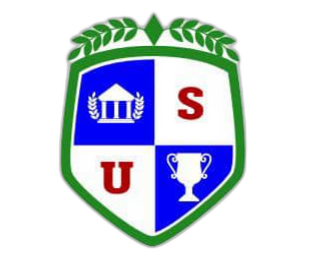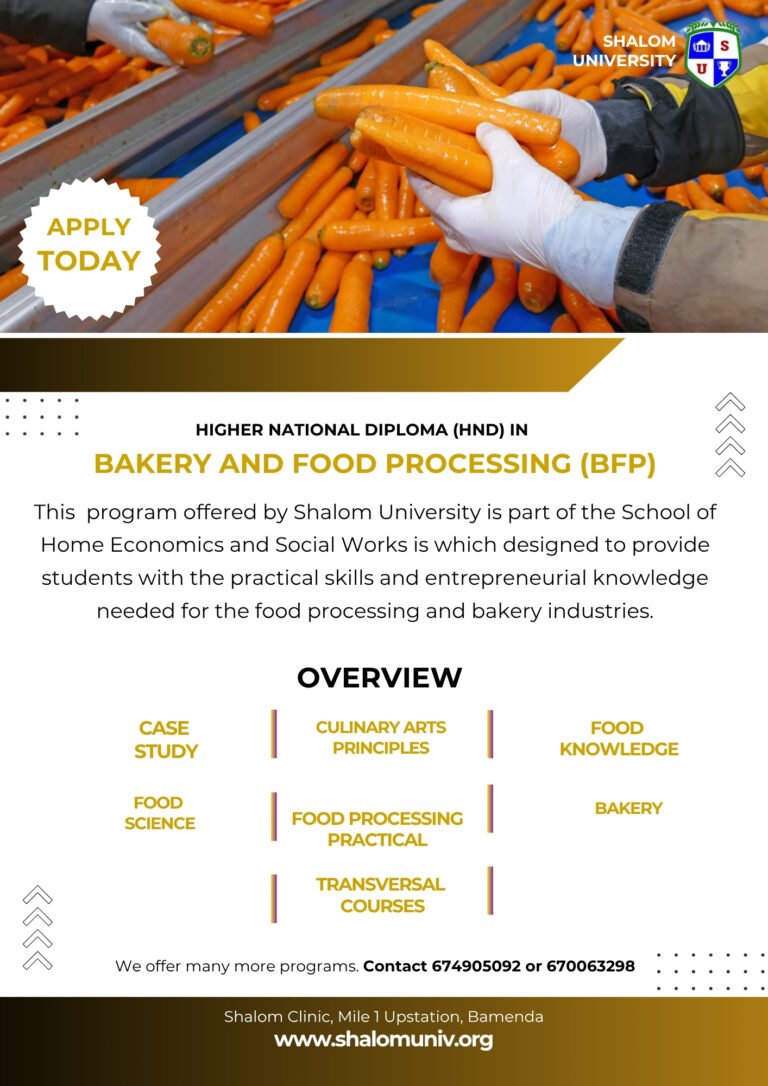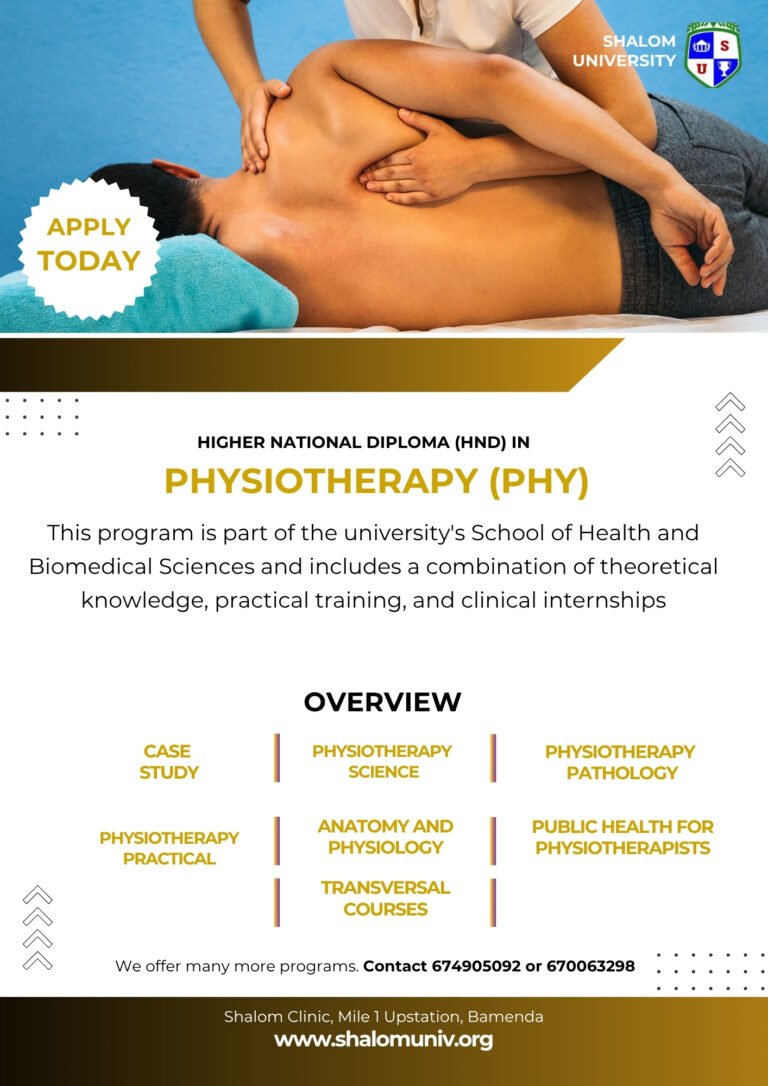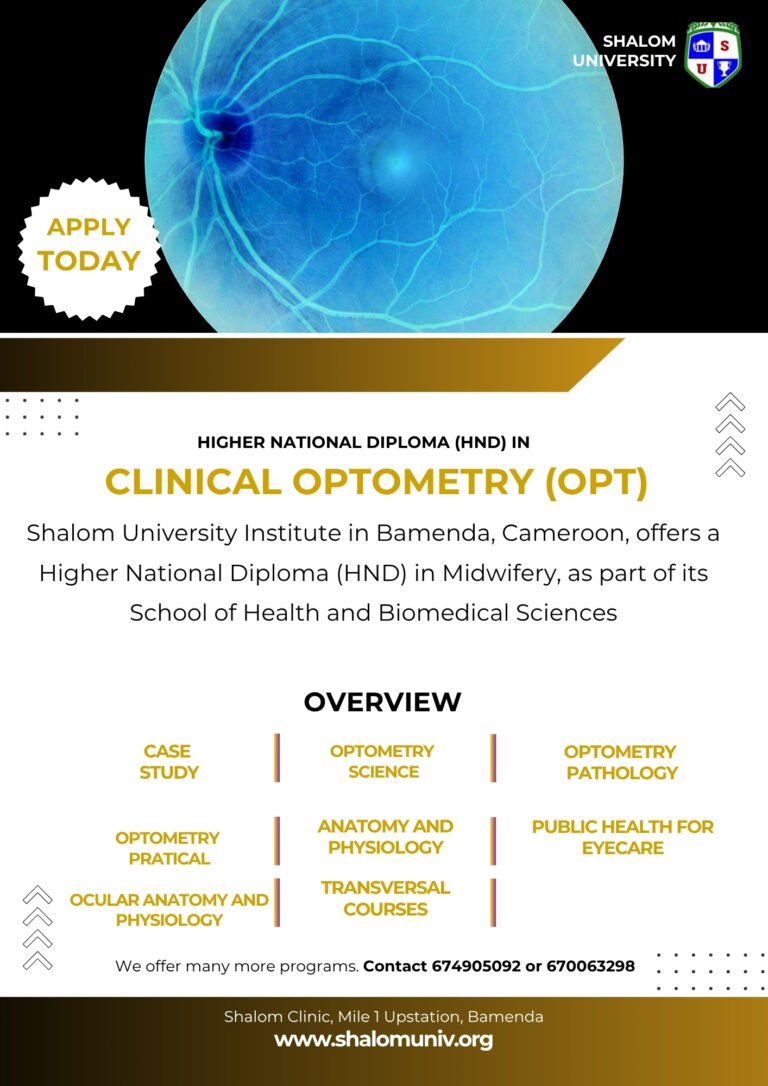In Cameroon, the field of Medical Imaging Technology (MIT) has become an indispensable part of modern healthcare. It provides the diagnostic tools that allow clinicians to see inside the human body, enabling accurate diagnoses, effective treatment planning, and monitoring of disease progression. For ambitious students seeking a career at the intersection of technology and medicine, Shalom University in Bamenda offers an accredited HND in Medical Imaging Technology. This program is specifically designed to meet the demands of the Cameroonian healthcare landscape, preparing graduates to operate and manage complex imaging equipment with precision and expertise.
The HND in MIT at Shalom University goes beyond theoretical knowledge, emphasizing hands-on training and critical thinking to develop competent professionals. The curriculum is comprehensive, covering the essential facets of the field to ensure graduates are well-rounded and ready to serve in a variety of clinical settings across Cameroon, from bustling city hospitals to rural health centers. The program’s core structure is built around six papers that integrate the scientific principles, practical application, safety protocols, and analytical skills needed for success.
The MIT Curriculum at Shalom University
The HND program at Shalom University is rooted in a structured curriculum that provides students with the foundational knowledge and advanced skills necessary to excel in the field. Each paper builds upon the last, culminating in a robust understanding of medical imaging.
Paper: Medical Imaging Science I
This foundational course introduces students to the core scientific principles and terminology that govern medical imaging. It provides the essential building blocks for understanding how different imaging modalities function and how they interact with the human body.
Key topics covered include:
- Basic Anatomy and Physiology: A solid grasp of human anatomy and the functions of the body’s systems is critical for understanding medical images. This provides the context needed to accurately interpret images and identify abnormalities.
- Radiation Science: Students learn about the fundamental physics of radiation, including its types, properties, and interactions with matter. This includes an understanding of radiation units, doses, and the biological effects of radiation exposure, laying the groundwork for safe practice.
- Imaging Principles: An overview of the basic principles of different imaging techniques, such as conventional X-ray, serves as an introduction to more complex modalities taught later in the program.
- Patient Care and Communication: Given the importance of patient safety and comfort, this module introduces students to effective communication skills, patient handling techniques, and ethical considerations in a clinical setting.
Paper: Medical Imaging Science II
Building on the foundation of the first science paper, this course delves into more advanced concepts and modern imaging modalities. It expands students’ knowledge base to include sophisticated techniques that are increasingly used in Cameroonian hospitals.
The curriculum covers:
- Advanced Modalities: An in-depth study of techniques such as Computed Tomography (CT), Magnetic Resonance Imaging (MRI), and Ultrasonography (USG). Students learn the principles behind these technologies, how the equipment operates, and their specific clinical applications.
- Digital Imaging: As healthcare becomes more digitized, understanding digital image acquisition, processing, and storage is paramount. This module covers Picture Archiving and Communication Systems (PACS) and the principles of digital radiography.
- Radiation Protection: This course provides a deeper look at radiation safety and protection, including the application of ALARA (As Low As Reasonably Achievable) principles, shielding, and radiation monitoring.
- Radiotherapy Principles: An introduction to the basic principles of radiotherapy, a key area for cancer treatment. While not a full specialization, this knowledge is vital for comprehensive patient care and understanding the full scope of medical imaging applications.
Paper: Physics and Techniques of Medical Imaging
This paper provides a detailed, technical understanding of the physics governing each imaging modality and the practical techniques used to produce high-quality diagnostic images. It is where students develop the technical proficiency required to operate advanced equipment.
Topics include:
- X-Ray Production: An exploration of how X-rays are generated, the components of an X-ray tube, and the factors affecting image quality and intensity.
- Techniques for Specific Modalities: Detailed instruction on the techniques and protocols for performing different types of examinations, such as CT scans, MRIs, and ultrasounds.
- Image Optimization: Students learn how to manipulate technical factors to optimize image quality while minimizing radiation dose, a crucial skill for ensuring patient safety and diagnostic accuracy.
- Image Processing and Analysis: An introduction to the software and computer systems used to process and analyze medical images, preparing students for the technological realities of modern imaging departments.
Paper: Quality Control in Medical Imaging
Quality control (QC) is essential for ensuring the accuracy, reliability, and safety of medical imaging. This paper equips students with the skills to monitor and maintain the performance of imaging equipment and processes.
The curriculum addresses:
- QC Protocols: Students learn how to perform routine quality control tests on imaging equipment, including calibration and performance monitoring, in line with international standards.
- Radiation Safety Audits: Training in conducting radiation safety audits to ensure compliance with radiation protection regulations and minimize radiation risk to both patients and staff.
- Image Quality Assessment: Methods for objectively and subjectively assessing image quality, identifying artifacts, and troubleshooting technical issues that compromise diagnostic value.
- Record Keeping: Procedures for documenting and reporting QC results to maintain a reliable and auditable record of equipment performance, a critical component in any healthcare facility.
Paper: Practice of Medical Imaging
This paper is the practical culmination of all the theoretical knowledge and technical skills learned. It is where students gain hands-on experience in a real-world clinical setting under the guidance of experienced professionals.
Key components include:
- Clinical Rotations: Students complete supervised clinical rotations in various imaging departments, including general radiography, CT, MRI, and ultrasound. This exposes them to diverse patient cases and clinical environments.
- Patient Positioning: Mastery of correct patient positioning techniques for a wide range of examinations, ensuring accurate and reproducible images.
- Emergency Procedures: Training in handling emergency medical imaging situations, including trauma and stroke protocols, is crucial for effective care in Cameroonian hospitals.
- Professionalism and Ethics: Reinforcement of professional conduct, patient privacy, and ethical decision-making in the workplace.
Paper: Case Study
The Case Study paper is the capstone of the HND program, integrating all the knowledge and skills learned into a critical thinking and problem-solving exercise. It prepares students for the complex, real-world challenges they will face as professionals.
In this paper, students are tasked with:
- Case Analysis: Analyzing real or simulated patient cases that require the use of medical imaging.
- Procedural Planning: Developing a comprehensive imaging plan, including the selection of appropriate modalities and technical protocols.
- Image Interpretation: Critically evaluating and interpreting the images produced, correlating findings with clinical information.
- Reporting: Formulating a concise and accurate report of their findings, presenting it clearly and professionally.
- Defense: Defending their decisions and findings in a formal presentation, demonstrating their mastery of the subject matter and their ability to think critically under pressure.
The Impact in Cameroon
Graduates of the HND in Medical Imaging Technology from Shalom University are well-prepared to serve the Cameroonian community. They possess the skills to operate sophisticated equipment, ensure patient safety through proper quality control and radiation protection, and contribute to accurate diagnoses, which are vital for improving public health outcomes. The focus on practical training and case-based learning ensures that these professionals can adapt to the varied challenges and resources available in different healthcare settings across the country. By providing a quality, locally-focused education, Shalom University plays a significant role in strengthening Cameroon’s medical imaging workforce and advancing the standard of healthcare in the region.




